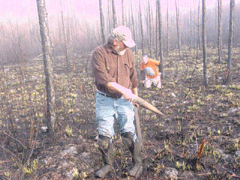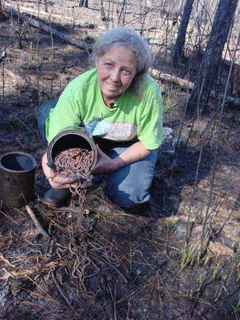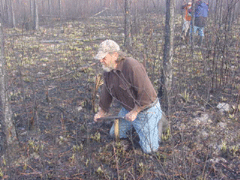Worm Grunters
Air Date: Week of March 13, 2009

Gary and Audrey Revell go worm grunting in the Apalachicola Forest. (Photo: Warren Duzak)
For generations, the Revell family has gone into the Apalachicola National Forest in Florida to collect bait worms using a technique called worm grunting. With a stake and metal bow in hand, they make vibrations in the ground and cause worms to rise to the surface by the thousands. Reporter Peter White went with the Revells on a recent early morning to find out how this technique works.
Transcript
GELLERMAN: They say the early bird catches the worm, but one Florida family gives the bird a run for its money.
Peter White got down and dirty to bring us this story.
WHITE: It’s just after sunrise in the Apalachicola National Forest in Northern Florida. A hazy mist hangs in the air—and there’s dew on the ground. A hundred foot pine trees stand like soldiers on parade.
Just another day at the office for Gary and Audrey Revell and their 33-year-old son, Snap.
SNAP REVELL: Alright Mom, let’s do it.
[SOUND OF WALKING]
WHITE: Gary and Snap each carry a stob – a hardwood stake about two feet long sharpened to a point. Their other tool is a flat steel bar called a rooping iron. An inch thick, it weighs ten pounds and is tapered at one end to fit your hand.
[SOUNDS OF POUNDING AND GRUNTING]
WHITE: They pound their stakes into the ground with the flat of the iron.
[SOUNDS OF POUNDING AND GRUNTING]
WHITE: And make them vibrate by rubbing the iron back and forth across the top of the stob. What they’re doing is hunting for worms.
[SOUNDS OF POUNDING AND GRUNTING]

Audrey Revell’s bucket overfloweth with worms. (Photo: Warren Duzak)
Gary REVELL: Once you make the right music, they’ll go to dancing for you. Hopefully, I’m doing it. [laughter]
WHITE: The Revell clan has been harvesting worms this way for generations. Some call it worm grunting. They call it rooping.
GARY RVELL: That’s just a term we came up with. Some people call it scrub bait, scrubbing the stob…grunt..grunt worms..maybe some would say charming or fiddlin’ whatever.
WHITE: By whatever name - it works.
I can feel the vibrations under my feet. Out of the ground come earthworms by the dozens. I can’t believe my eyes.
WHITE: There’s one, there’s another, there’s another.
Audrey crouches low and moves quickly, snatching up worms as they leave their burrows. Her gallon bucket is soon full.
AUDREY REVELL: That’s 500 worms. That’s a full can.
WHITE: On a good day, one grunter can keep two collectors busy. Some grunters use smaller stakes and lighter irons, says Gary.
GARY REVELL: They make a high pitch…(he mimics sound)….while ours has got a rumble to it. They both work.
WHITE: Gary and Snap read the ground like a map: small holes and worm castings—the presence of birds are good signs. The white sand mounds made by crawfish tell them the ground is low and moist here. The weather and even the phase of the moon affect how well they will do.
[SOUNDS OF POUNDING]
WHITE: Snap pounds his stob about a foot into the ground - and begins to draw his iron across the top, playing it like a giant fiddle. Then he pounds again. The tone changes as the point of the stob reaches down to the dense sand or pan below the topsoil.

Gary Revell uses his tools of the trade. (Photo: Warren Duzak)
[SOUND OF ROOPING]
SNAP REVELL: Normally when you notice the bait start surfacing is when it gets into that hard pan and then the vibration travels a little better.
[SOUND OF ROOPING]
WHITE: The shorter the stob gets the higher the pitch. It sounds like a raspy saxophone solo. But the longer the stob the lower the pitch.
GARY REVELL: Apparently these are more Beethoven type. [laughter]
WHITE: Gary lets me have a go at it. It’s definitely harder than it seems.
He gets ten worms to every one I coax out of the ground. But why does it work? That’s what biologist Ken Catania of Vanderbilt University was determined to find out.
CATANIA: When you think about all the predators and things that like to eat earthworms, you would imagine that they should go down when there is a vibration or something digging or some sort of disturbance on the ground. But instead they’re going the wrong way, they’re streaming out of the ground. So that’s sort of an irresistible mystery, why would they do that?
WHITE: He got a tip from a slim volume about earthworms written by Charles Darwin in 1881.
CATANIA: In that book he pointed out that ‘It has often been said that if the ground is beaten or otherwise made to tremble, worms believe they are being pursued by a mole and leave their burrows. And I thought that was just a great clue to what might be going on.
WHITE: So Catania went down to the Apalachicola Forest to meet the Revells and study their technique. The first thing he discovered was that lots of eastern moles live in the forest. Next, he measured the vibrations made by the Revells and the vibrations made by digging moles. They overlapped. Then he put the worms and moles together to see what happened.

Gary and Audrey Revell go worm grunting in the Apalachicola Forest. (Photo: Warren Duzak)
CATANIA: It was amazing to see. So as soon as that mole dug down into the dirt, up came the earthworms, sort of streaming out of the ground in front of it. Basically, looking like they were running, if you could describe a worm as running. They were moving about as fast as a worm could go.
WHITE: Why up and not down? Because moles won’t chase worms above ground for fear of becoming prey themselves. Earthworms come out of the ground to escape their worst enemy, only to be caught by the Revells. Biologists call this hunting strategy exploitive mimicry. It is used by a rare predator—in this case a worm-grunter who takes advantage of a prey’s escape response to its main predator. Wood turtles and seagulls do the same thing the Revells do. They tap the ground pretending to be a mole and the worms come up.
[GRUNTING]
WHITE: Back in the forest, the Revells have collected six cans of worms in about three hours.
GARY REVELL: There’s a whole lot of grunting going on out here, that’s for sure.
WHITE: The sun has climbed overhead. It’s time to go back to the shop and count them out into little blue containers, which they sell to bait shops.
[SOUNDS OF PUTTING CANS INTO TRUCK. “SET ‘EM IN THE SHADE”]
WHITE: The Revells live pretty much off the grid, but wouldn’t put it that way. Rather, outside of town where it’s quiet and the living is easy.
GARY REVELL: It’s totally different and once you’re accustomed to this type of living, it’s hard to cope with any other.
WHITE: People drop by to chew the fat, and if the Revells aren’t home, they count their own worms and leave the money in a box in the bait shop. Next month the Revells will give demonstrations at the annual worm grunting festival in the small town of Sopchoppy, Florida. They’ll be there with the stakes, and irons, and thousands of worms they’ve brought from the forest just for the occasion.
For Living on Earth, this is Peter White.
Links
Living on Earth wants to hear from you!
Living on Earth
62 Calef Highway, Suite 212
Lee, NH 03861
Telephone: 617-287-4121
E-mail: comments@loe.org
Newsletter [Click here]
Donate to Living on Earth!
Living on Earth is an independent media program and relies entirely on contributions from listeners and institutions supporting public service. Please donate now to preserve an independent environmental voice.
NewsletterLiving on Earth offers a weekly delivery of the show's rundown to your mailbox. Sign up for our newsletter today!
 Sailors For The Sea: Be the change you want to sea.
Sailors For The Sea: Be the change you want to sea.
 The Grantham Foundation for the Protection of the Environment: Committed to protecting and improving the health of the global environment.
The Grantham Foundation for the Protection of the Environment: Committed to protecting and improving the health of the global environment.
 Contribute to Living on Earth and receive, as our gift to you, an archival print of one of Mark Seth Lender's extraordinary wildlife photographs. Follow the link to see Mark's current collection of photographs.
Contribute to Living on Earth and receive, as our gift to you, an archival print of one of Mark Seth Lender's extraordinary wildlife photographs. Follow the link to see Mark's current collection of photographs.
 Buy a signed copy of Mark Seth Lender's book Smeagull the Seagull & support Living on Earth
Buy a signed copy of Mark Seth Lender's book Smeagull the Seagull & support Living on Earth

